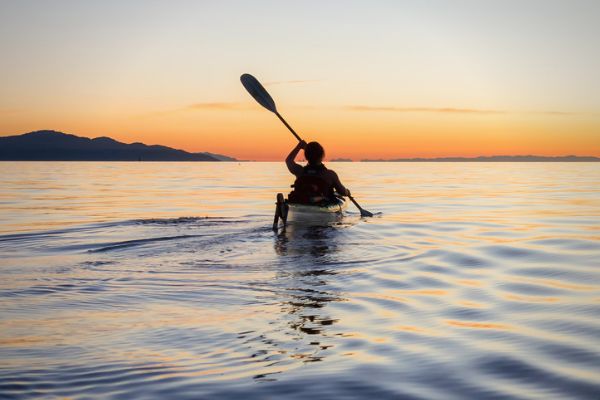Welcome to my guide on how to paddle a fishing kayak faster. There are many reasons why you might want to paddle faster.
Maybe to spend more time fishing and less paddling? or simply keep up with faster mates on the water. In this guide, I will share my knowledge from kayak racing on sneaky ways to get a little extra speed out of your kayaks.
I use these tricks to beat all of my mates to the best fishing spots.
Manufacturers design fishing kayaks with functionality and stability in mind. They are wide heavy boats, often with raised cushioned seats. Not designed for performance paddling or even speed. Some people resort to pedal drives or electric motors, but both options add weight and expense to a kayak.
What if I were to tell you, that it is possible to paddle faster without paddling harder?
It is always possible to get faster by getting fitter, or by improving one’s technique (easier said than done in most fishing kayaks).
In this article, I am going to suggest ways to paddle faster, without requiring dedicated training or replacing your kayak.
Interested in why I think kayaks are the best watercraft for targeting trout check here.
Avoid the wind, or use it to your advantage.
I see this all of the time, people paddling directly into the wind.
On windy days, keep out of the wind when your route allows it. One side of a river or lake is usually more sheltered than the other. Use the shoreline to shelter yourself from the full force of the wind.
On meandering, rivers consider crossing at every bend to keep out of the wind.
The opposite applies when heading downwind, try to take full advantage and head towards the middle to catch the full force of the wind. When wavy, it might even be possible to surf along a little.
Work with the current to gain speed.
Most experienced river fishermen know rivers do not flow at a consistent speed across their entire width.
Even gentle flowing rivers there is usually current and its speed changes throughout the width of the river.
The current is typically fastest out in the middle and slowest next to the shoreline where a series of eddies often form. Sticking to the eddies can easily be 10-20% faster than fighting the full force of the current.
Paddling on the inside of a bend is also generally quicker than paddling on the outside. Just watch out for shallow sand bars.
So when paddling upstream to your fishing spot, keep as close to the bank as possible and let the eddies push you upstream.
When paddling shallow water is slow, and deep water is fast.
Bottom drag on kayaks exists. I do not understand the science behind it, but paddling in shallow water is tougher than deep water.
When paddling fast, always try to paddle in water at least a few feet deep. I nearly always prioritize deep water over keeping out of the current. Shallow patches are just a slog to paddle across.
Change your paddle – gain up to 5% more power per stroke.
Upgrading to a better paddle can allow you to paddle faster.
Cheap paddles rarely have efficient blade designs and are usually made from inexpensive heavy material. When kayaking you have to take thousands of strokes every day, so every extra ounce makes a difference.
Heavy paddles are tiresome to hold and paddle with. Paddling with a lightweight full carbon paddle saves a lot of energy, allowing for longer fishing trips with less effort.
Here I have written an article on choosing the best paddle for your fishing kayak.
Wash ride behind others
Struggling to keep up with a faster mate? Then position your kayak so it sits o the wash just behind their kayak. You get dragged along for free. If there are two faster kayaks, try to set behind them on their V wash. Paddling on another’s wash can use up to 20% less energy. Imagine you are a Canadian goose flying in formation.
The front paddler also helps to block the wind and smooth the chop. If everyone is similar in speed, take turns in the lead. Allowing the other to rest behind. For obvious reasons, this does not work well when trolling.
Raise your sitting position
If your kayak is sufficiently stable enough, a higher sitting position allows for a more powerful stroke. So raising the seat by an inch or two can allow you to generate more power per stroke which generates more speed.
A kayaker’s paddle is their gear lever, change its length.
Changing the length of an adjustable paddle is a bit like changing gears on a bike. A longer shaft is good for more power.
While a shorter shaft is easier to maintain a high cadence (strokes per minute). When I am battling upstream or into the wind, I often shorten my paddle length so my cadence does not suffer.
When paddling is easy, and you are feeling stronger, extend the shaft a cm or two. At the end of a day, or pushing into the wind. Shorten the blade to maintain cadence and forward momentum.

